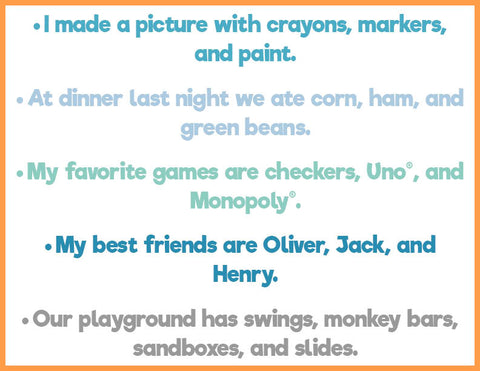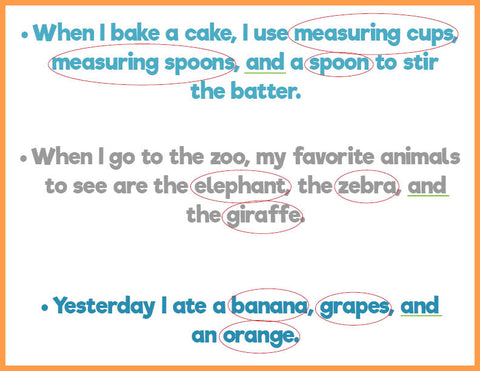How to Teach Punctuation for Items in a Series
I have to confess that when I remember back to my early school years, I can't recall if I had trouble with the concept of identifying items in a series and knowing where to put the commas. However, my own students in second grade really struggled with this idea. It took me by surprise because I assumed it was going to be one of those skills that I could show them, and they would all just nod and say, “Sure, got it!” But that is not what happened.
In thinking this through after the fact, I wonder if poor reading comprehension might have been at the root of their difficulty. Or maybe we should have first of all introduced the concept with the children in a hands-on activity so they could understand better. At any rate, it is really fun to teach this concept in a right-brain-friendly way: tangible, hands-on, using visuals, etc.

What You Will Need
- Chart paper or whiteboard
- Lined paper or personal whiteboards
- Pencils, markers, and/or crayons
- Collection of objects (physical or pictures)
- Sample sentences containing items in a series

How to Teach
- To prepare for the lesson, write the sample sentences on chart paper leaving plenty of room between each sentence. You will use this starting in step 10.
- Gather the children close so they can see well.
-
Introduce the lesson by sharing how frequently we mention items in a series when we are talking to someone. Use the objects or pictures you collected. The following are examples:
Show the children the baking tools and say, “When I bake a cake, I use measuring cups, measuring spoons, and a spoon to stir the batter.” Show the animals you brought and say, “When I go to the zoo, my favorite animals to see are the elephant, the zebra, and the giraffe.” Show them the plastic foods you brought and say, “Yesterday I ate a banana, grapes, and an orange.” -
Next, tell the children you are going to show them on your chart paper the same thing you just talked about. Display a clean sheet of paper and write, thinking out loud so they can see what you are thinking as you write. Write the example sentences that you talked about in step 3, leaving plenty of room between each sentence.
- Ask children to come up and circle the three items in each sentence.
- Point out the fact that each of the sentences has AND right before the last item. Underline AND in each sentence.

- Next, ask the children to take turns sharing three items with the class. It could be three animals, three favorite foods, three favorite cartoons, etc.
- Prompt them to write a simple sentence on their paper or whiteboards, using the three items they chose. The sentence could be as simple as, "I like snakes, lizards, and bats."
- When they have all written a sentence, have them circle the items and underline the AND right before the last item. Allow children to share their sentences.
- Display the sample sentences you prepared earlier. Read the first sentence, "I made a picture with crayons, markers, and paint."
-
Ask the children what the sentence is telling us. When they have identified the drawing tools as the items in the series, circle them. Underline the AND. Point out the commas that separate the items. Suggest that the commas keep the items separate so they don’t get mixed up.

-
Suggest that the children draw a picture on their paper or whiteboard of what happened in the sentence. For example, for sentence #1, they might draw a stick figure that made a picture. By the stick figure they could draw the tools that the stick figure used to draw his/her picture.
-
If you feel it is needed, rewrite the sentence below the first one, but instead of writing the words for the tools used, draw them instead.

-
Proceed to sentence #2, taking the same steps. The more examples you do together, the more this skill will become familiar to the children. The goal is to help the children practice often until they are able to instantly see items in a series and know to separate them by commas.
Conclusion
Try this fun and engaging hands-on lesson today to help your children understand this confusing concept. With a little practice, they will be fluent in identifying items in a series and knowing where to put the commas.
If you have any questions, please do not hesitate to contact us today!





Leave a comment